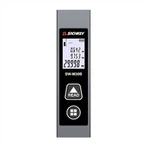Explanation of the lower measurement limit and self generated noise of a sound level meter
The definition of the total range of sound level meters in the new international standard for sound level meters IEC61672-1:2002 and the new metrological verification regulation for sound level meters JJG188-2002 is: the response to a sinusoidal signal, from the minimum sound level on the maximum sensitivity level range to the maximum sound level on the minimum sensitivity level range, the A-weighted sound level range that can be tested when there is no overload or underrange indication, and the level linear error is within the specified tolerance range. At the same time, it is stipulated that within any frequency weighting or frequency response range of the sound level meter, the linear error of the level plus the expanded uncertainty caused by the measurement (0.3dB) on all levels of any frequency range shall not exceed ± 1.1dB for the first level sound level meter and ± 1.4dB for the second level sound level meter. According to this, in order to ensure the requirement of level linear error, after deducting the influence of uncertainty, the self generated noise of level 1 sound level meters should be at least 8dB lower than the lower measurement limit, and level 2 sound level meters should be at least 6.7dB lower. They are required to be at least 5dB lower than the old standard.
However, many manufacturers currently set the self generated noise (background noise) value as the lower measurement limit of the sound level meter, which is clearly misleading users. Users should pay attention when selecting this type of sound level meter, as the actual measurement lower limit is 6.7dB~8dB higher than what they provide. Some manufacturers still use the old national and international standards for sound level meters to measure lower limits that are 5dB higher than the background noise, which is not accurate enough.
The measurement lower limit of a sound level meter mainly depends on the sensitivity of the microphone and the self generated noise of the sound level meter. To reduce the measurement lower limit, it is necessary to start from these two aspects. In the new international standards and regulations, manufacturers are required to provide * high self generated sound noise and self generated electrical noise respectively. It is required to measure the self generated sound noise when placing the sound level meter in a low noise sound field. As some are only low noise sound fields for the A sound level, only the A sound level of the self generated sound noise can be measured at this time. The self generated electrical noise is measured by replacing the microphone with equivalent impedance. We know that microphones also generate self generated noise (thermal noise), so the self generated sound noise of sound level meters is usually greater than electrical noise. The equivalent impedance of a microphone is basically a capacitor, with a capacitance of approximately 50pF for a 1-inch microphone and 15pF for a 1/2-inch microphone. The self generated noise obtained from different capacitance tests will vary. When testing for self generated electrical noise, adapters used for electrical signal transfer should not be used. These adapters have a built-in capacitor of 0.01 μ F or 0.1 μ F. The electrical noise measured with it will be significantly lower. In addition, when measuring self generated noise, the arithmetic mean of 10 readings should be randomly read within 60 seconds for the F and S time weighted sound levels, rather than the maximum reading value. For the time averaged sound level, the average time should be at least 30 seconds.






